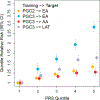Genome-wide association analyses identify 95 risk loci and provide insights into the neurobiology of post-traumatic stress disorder
- PMID: 38637617
- PMCID: PMC11396662
- DOI: 10.1038/s41588-024-01707-9
Genome-wide association analyses identify 95 risk loci and provide insights into the neurobiology of post-traumatic stress disorder
Abstract
Post-traumatic stress disorder (PTSD) genetics are characterized by lower discoverability than most other psychiatric disorders. The contribution to biological understanding from previous genetic studies has thus been limited. We performed a multi-ancestry meta-analysis of genome-wide association studies across 1,222,882 individuals of European ancestry (137,136 cases) and 58,051 admixed individuals with African and Native American ancestry (13,624 cases). We identified 95 genome-wide significant loci (80 new). Convergent multi-omic approaches identified 43 potential causal genes, broadly classified as neurotransmitter and ion channel synaptic modulators (for example, GRIA1, GRM8 and CACNA1E), developmental, axon guidance and transcription factors (for example, FOXP2, EFNA5 and DCC), synaptic structure and function genes (for example, PCLO, NCAM1 and PDE4B) and endocrine or immune regulators (for example, ESR1, TRAF3 and TANK). Additional top genes influence stress, immune, fear and threat-related processes, previously hypothesized to underlie PTSD neurobiology. These findings strengthen our understanding of neurobiological systems relevant to PTSD pathophysiology, while also opening new areas for investigation.
© 2024. This is a U.S. Government work and not under copyright protection in the US; foreign copyright protection may apply.
Conflict of interest statement
L.J.B. is listed as an inventor on Issued U.S. Patent 8,080,371, “Markers for Addiction” covering the use of certain SNPs in determining the diagnosis, prognosis, and treatment of addiction. C.-Y.C. and H.R. are employees of Biogen. A.M.D. holds equity in CorTechs Labs, Inc., and serves on the Scientific Advisory Board of Human Longevity, Inc., and the Mohn Medical Imaging and Visualization Centre; A.M.D. receives funding through research grants with General Electric Healthcare. C.F. was a speaker for Janssen in 2021. I.B.H. is the Co-Director, Health and Policy at the Brain and Mind Centre (BMC) University of Sydney; the BMC operates an early-intervention youth services at Camperdown under contract to headspace. I.B.H. is the Chief Scientific Advisor to, and a 3.2% equity shareholder in, InnoWell Pty Ltd; InnoWell was formed by the University of Sydney (45% equity) and PwC (Australia; 45% equity) to deliver the $30 M Australian Government-funded Project Synergy. H.H. received consultancy fees from Ono Pharmaceutical and honorarium from Xian Janssen Pharmaceutical. In the past 3 years, R.C.K. was a consultant for Cambridge Health Alliance, Canandaigua VA Medical Center, Holmusk, Partners Healthcare, Inc., RallyPoint Networks, Inc., and Sage Therapeutics. He has stock options in Cerebral Inc., Mirah, PYM, Roga Sciences and Verisense Health. L.A.M.L. reports spousal IP payments from Vanderbilt University for technology licensed to Acadia Pharmaceuticals unrelated to the present work. C.M. has served on advisory boards of Receptor Life Sciences, Otsuka Pharmaceuticals and Roche Products Limited and has received support from National Institute on Alcohol Abuse and Alcoholism, National Institute of Mental Health, Department of Defense- CDMRP * US Army Research Office * DARPA, Bank of America Foundation, Brockman Foundation, Cohen Veterans Bioscience, Cohen Veterans Network, McCormick Foundation, Home Depot Foundation, New York City Council, New York State Health, Mother Cabrini Foundation, Tilray Pharmaceuticals, and Ananda Scientific. P.M.P. received payment or honoraria for lectures and presentations in educational events for Sandoz, Daiichi Sankyo, Eurofarma, Abbot, Libbs, Instituto Israelita de Pesquisa e Ensino Albert Einstein, Instituto D’Or de Pesquisa e Ensino. R.P. has been paid for his editorial work on the journal
Figures












References
-
- Davis LL et al. The Economic Burden of Posttraumatic Stress Disorder in the United States From a Societal Perspective. J Clin Psychiatry 83, 21m14116 (2022). - PubMed
Methods-only references
Publication types
MeSH terms
Grants and funding
- R01 MH124851/MH/NIMH NIH HHS/United States
- R01 MD011728/MD/NIMHD NIH HHS/United States
- IK2 RX002922/RX/RRD VA/United States
- UL1 TR001863/TR/NCATS NIH HHS/United States
- UM1 TR004409/TR/NCATS NIH HHS/United States
- R01 MH124847/MH/NIMH NIH HHS/United States
- P50 HD103537/HD/NICHD NIH HHS/United States
- R01 MH106595/MH/NIMH NIH HHS/United States
- R01MH106595/U.S. Department of Health & Human Services | NIH | National Institute of Mental Health (NIMH)
- R01 MH123619/MH/NIMH NIH HHS/United States
- R01 MH121924/MH/NIMH NIH HHS/United States
- R01 HG012869/HG/NHGRI NIH HHS/United States
LinkOut - more resources
Full Text Sources
Medical
Research Materials
Miscellaneous

